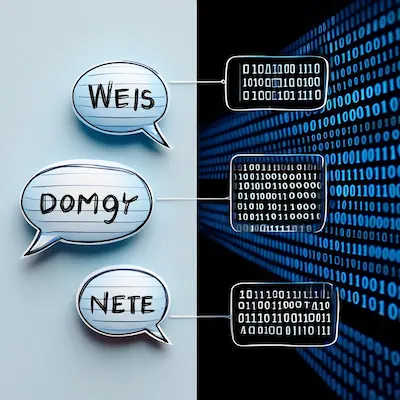One of the most remarkable achievements of modern Artificial Intelligence is its growing ability to understand, interpret, and generate human language. From the chatbots we interact with daily (like ChatGPT) to sophisticated translation services and sentiment analysis tools, the technology enabling this is Natural Language Processing (NLP). But how exactly does AI understand language, with all its nuances, ambiguities, and context-dependencies? This NLP explained 2025 guide for beginners will break down the core concepts, key techniques like NLU vs NLG, and real-world applications of this fascinating field.

1. What is Natural Language Processing (NLP)?
Natural Language Processing (NLP) is a subfield of Artificial Intelligence focused on enabling computers to process, analyze, understand, and generate human language (both text and speech) in a way that is valuable and meaningful. Essentially, NLP aims to bridge the gap between human communication and computer understanding.
Human language is incredibly complex: it's often ambiguous, context-dependent, filled with idioms, sarcasm, and cultural nuances. NLP employs a combination of computational linguistics (rule-based modeling of human language) and machine learning/deep learning algorithms to tackle these challenges.
2. Core Components of NLP: NLU and NLG
NLP can be broadly divided into two main components:
- Natural Language Understanding (NLU): This focuses on the "input" side – enabling machines to *comprehend* the meaning of human language. Key tasks in NLU include:
- Tokenization: Breaking down text into smaller units (words, sub-words, or characters) called tokens.
- Part-of-Speech (POS) Tagging: Identifying the grammatical role of each word (noun, verb, adjective, etc.).
- Named Entity Recognition (NER): Identifying and categorizing key entities in text, such as names of people, organizations, locations, dates, and monetary values.
- Sentiment Analysis: Determining the emotional tone or attitude expressed in a piece of text (positive, negative, neutral).
- Intent Recognition: Understanding the underlying goal or purpose of a user's query or statement.
- Coreference Resolution: Identifying when different words or phrases in a text refer to the same entity (e.g., "John went to the store. *He* bought milk." – knowing "He" refers to John).
- Parsing: Analyzing the grammatical structure of sentences to understand relationships between words.
- Natural Language Generation (NLG): This focuses on the "output" side – enabling machines to *produce* human-like language. Key tasks in NLG include:
- Text Planning: Deciding what information to include and how to structure it.
- Sentence Generation: Constructing grammatically correct and coherent sentences.
- Text Realization: Converting abstract representations of language into fluent, natural-sounding text. This includes choosing appropriate words, ensuring proper grammar, and maintaining a consistent style and tone.
Understanding the distinction between NLU vs NLG is key: NLU is about reading/listening and understanding, while NLG is about writing/speaking and generating.
3. Key NLP Techniques & Technologies in 2025
Several techniques and technologies underpin modern NLP advancements:
- Machine Learning (ML) & Deep Learning: Most state-of-the-art NLP systems in 2025 are built using ML, particularly deep learning models like Recurrent Neural Networks (RNNs), Long Short-Term Memory networks (LSTMs), and especially **Transformer models**. (See our Neural Networks Guide and LLM Guide).
- Word Embeddings (e.g., Word2Vec, GloVe, FastText): These are techniques that represent words as dense numerical vectors in a way that captures their semantic relationships. Words with similar meanings will have similar vector representations. This allows AI to understand synonyms and context better.
- Transformer Architecture: As mentioned, this architecture has revolutionized NLP due to its "attention mechanism," which allows models to weigh the importance of different words in a sentence when processing information, leading to better contextual understanding.
- Large Language Models (LLMs): Pre-trained on massive text corpora, LLMs serve as powerful foundation models for a wide range of NLP tasks. They can be fine-tuned for specific applications.
4. Real-World Applications of NLP in 2025
NLP is already deeply integrated into many applications we use daily:
- Search Engines: Understanding your search queries, even if they're phrased conversationally, and ranking relevant results (Semantic Search).
- Chatbots & Virtual Assistants: Powering conversational interfaces for customer service, personal assistance, and information retrieval. (See our Conversational AI post).
- Machine Translation (e.g., Google Translate): Automatically translating text or speech from one language to another with increasing accuracy and fluency.
- Sentiment Analysis Tools: Analyzing social media comments, customer reviews, or news articles to gauge public opinion or brand perception.
- Spam Filters & Email Categorization: Classifying emails as spam or legitimate, and automatically sorting emails into categories.
- Grammar & Spell Checkers: Identifying and correcting errors in written text.
- Text Summarization: Automatically generating concise summaries of long documents or articles.
- Voice Recognition & Synthesis: Converting spoken language to text (speech-to-text) and text to spoken language (text-to-speech).
5. Challenges and the Future of NLP
Despite incredible progress, NLP still faces challenges in 2025:
- Ambiguity & Nuance: Human language is inherently ambiguous. Understanding sarcasm, irony, subtle cultural references, and deeply implied meanings remains difficult for AI.
- Common Sense Reasoning: Integrating true common-sense knowledge into NLP models is an ongoing research area. (See our post on AI's Limits).
- Bias: NLP models can inherit and amplify biases present in their training data, leading to unfair or stereotypical outputs.
- Low-Resource Languages: Developing high-performing NLP tools for languages with less available digital text data is a challenge.
- Handling Disinformation & Harmful Content: Detecting and mitigating the generation or spread of harmful content through NLP models.
The future of NLP points towards even more sophisticated models that can understand deeper context, reason more effectively, engage in more fluid and multimodal conversations, and better navigate the complexities of human communication across diverse languages and cultures. As a core component of how AI understands language, NLP will continue to be a driving force in AI innovation.
What NLP application do you find most impressive or use most often?
